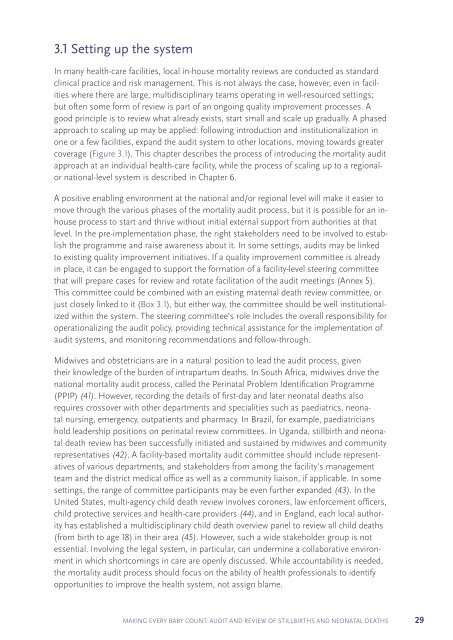Making Every Baby Count
9789241511223-eng
9789241511223-eng
You also want an ePaper? Increase the reach of your titles
YUMPU automatically turns print PDFs into web optimized ePapers that Google loves.
3.1 Setting up the system<br />
In many health-care facilities, local in-house mortality reviews are conducted as standard<br />
clinical practice and risk management. This is not always the case, however, even in facilities<br />
where there are large, multidisciplinary teams operating in well-resourced settings;<br />
but often some form of review is part of an ongoing quality improvement processes. A<br />
good principle is to review what already exists, start small and scale up gradually. A phased<br />
approach to scaling up may be applied: following introduction and institutionalization in<br />
one or a few facilities, expand the audit system to other locations, moving towards greater<br />
coverage (Figure 3.1). This chapter describes the process of introducing the mortality audit<br />
approach at an individual health-care facility, while the process of scaling up to a regionalor<br />
national-level system is described in Chapter 6.<br />
A positive enabling environment at the national and/or regional level will make it easier to<br />
move through the various phases of the mortality audit process, but it is possible for an inhouse<br />
process to start and thrive without initial external support from authorities at that<br />
level. In the pre-implementation phase, the right stakeholders need to be involved to establish<br />
the programme and raise awareness about it. In some settings, audits may be linked<br />
to existing quality improvement initiatives. If a quality improvement committee is already<br />
in place, it can be engaged to support the formation of a facility-level steering committee<br />
that will prepare cases for review and rotate facilitation of the audit meetings (Annex 5).<br />
This committee could be combined with an existing maternal death review committee, or<br />
just closely linked to it (Box 3.1), but either way, the committee should be well institutionalized<br />
within the system. The steering committee’s role includes the overall responsibility for<br />
operationalizing the audit policy, providing technical assistance for the implementation of<br />
audit systems, and monitoring recommendations and follow-through.<br />
Midwives and obstetricians are in a natural position to lead the audit process, given<br />
their knowledge of the burden of intrapartum deaths. In South Africa, midwives drive the<br />
national mortality audit process, called the Perinatal Problem Identification Programme<br />
(PPIP) (41). However, recording the details of first-day and later neonatal deaths also<br />
requires crossover with other departments and specialities such as paediatrics, neonatal<br />
nursing, emergency, outpatients and pharmacy. In Brazil, for example, paediatricians<br />
hold leadership positions on perinatal review committees. In Uganda, stillbirth and neonatal<br />
death review has been successfully initiated and sustained by midwives and community<br />
representatives (42). A facility-based mortality audit committee should include representatives<br />
of various departments, and stakeholders from among the facility’s management<br />
team and the district medical office as well as a community liaison, if applicable. In some<br />
settings, the range of committee participants may be even further expanded (43). In the<br />
United States, multi-agency child death review involves coroners, law enforcement officers,<br />
child protective services and health-care providers (44), and in England, each local authority<br />
has established a multidisciplinary child death overview panel to review all child deaths<br />
(from birth to age 18) in their area (45). However, such a wide stakeholder group is not<br />
essential. Involving the legal system, in particular, can undermine a collaborative environment<br />
in which shortcomings in care are openly discussed. While accountability is needed,<br />
the mortality audit process should focus on the ability of health professionals to identify<br />
opportunities to improve the health system, not assign blame.<br />
MAKING EVERY BABY COUNT: AUDIT AND REVIEW OF STILLBIRTHS AND NEONATAL DEATHS<br />
29
















